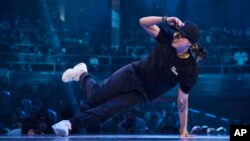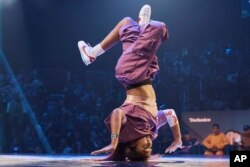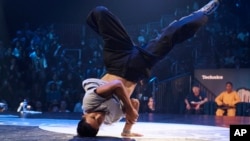A new sport calls for new rules at the Olympic level. And while breaking — commonly referred to as breakdancing — has been around for decades, it's still new to the world of Olympic judging.
The battles, the moves and the culture aren't new — breaking is one of four foundational elements of hip-hop, the 50th anniversary of which was celebrated last year. The international competitions aren't new either — the Red Bull BC One World Final has been around for two decades and the sport resonated among younger viewers at the 2018 Youth Olympic Games in Buenos Aires. Still, many remain skeptical of the Olympic addition as they tune in for the final few days of the Paris Games.
“I think the critics have a misconception about breaking still being something from the '80s or something that is just in the streets, and I don’t think they realize how much it’s evolved,” said Ronnie Abaldonado, or b-boy Ronnie, a breaker who's competed, judged and taught for 31 years. Abaldonado is one of NBC's official commentators for the breaking competition.
“It’s going to be undeniable once they see it on the big stage and they see the spectacle and the level of talent and even the high level of difficulty,” he said. “You could kind of compare it to gymnastics.”
At its root, breaking is an art form that connects mind, body and soul. Judges will score breakers using the Trivium judging system, created for breaking's debut at the Buenos Aires Youth Games. A panel of nine judges scores each breaker on technique, vocabulary, execution, musicality and originality — each accounts for 20% of the final score.
Breaking is judged qualitatively because of its roots as an art form, and judges use a sliding scale to score each round and battle, adjusting the scale towards the breaker who is winning in each of the above criteria. Throughout, an emcee will offer commentary and hype up the crowd. The judges for the Olympic competition have not yet been made public.
“What looks so appealing to the naked eye are the power moves, like the ‘air’ moves, the head spins, the ground power, which are like the windmills and freezes,” Abaldonado said. “It's the strength, the control and the speed that's also visually appealing.”
A judge will be looking at the technical side, though, “which is like the footwork and dancing on the music or the beat, because that’s like the DNA of breaking,” Abaldonado said. What's more, he said, there needs to be an element of improvisation, which feeds into the originality score. The DJ selects the music — and the breakers won't know what soundtrack they'll be competing to until they hit the floor.
“We practice and rehearse everything, but we also have to adapt in the moment and improvise,” said Victor Montalvo, or b-boy Victor, representing Team USA. “We try not to have a fully rehearsed round, because it tends to look robotic.”
For Tony “Mr. Wave” Wesley, a breaking pioneer from the Bronx who was launched into stardom decades ago with the New York City Breakers, seeing breaking make its imprint on the global stage is validating. Now, he's trying to pass on his institutional knowledge by creating a virtual lesson plan that includes flashcards on breaking's elements and terminology for the digital learning platform Quizlet.
“I always felt that we didn’t do enough for the newer generations. And then I saw my peers dying, leaving us, and all we had was their stories, and they took those with them. So someone has to write that story,” Wesley said.
Here is a breakdown of the five criteria on which judges will evaluate breakers:
Technique: Maintaining physiological control while focusing on athleticism, form and spatial awareness.
Vocabulary: The range of moves that display variation and the quantity of moves, ideally with minimal repetition.
Execution: The ability to land and perform moves smoothly, without falls or slips and while maintaining consistency and flow.
Musicality: The ability to stay on beat, syncing movements to the rhythm of the music.
Originality: The capacity for improvisation, creativity and maintaining spontaneity with style and personality.









